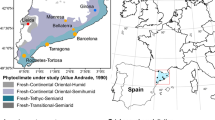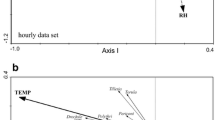Abstract
In this study we report an aerobiological sampling of the atmosphere of Córdoba, in which airborne conidia belonging to the genusCladosporium were volumetrically counted for a period of 3 years. Two types ofCladosporium conidia were identified, differentiated by their morphological characteristics: the typecladosporioides and the typeherbarum. Correlation analyses with meteorological parameters have shown that daily mean temperature and relative humidity were the most influential factors governing the daily presence ofCladosporium in the atmosphere. Regression analyses were also done in order to establish predictive models of future airborne concentrations. The models that have shown the best adjustment to our data set have been obtained through the utilization of the weekly average temperature prior to the conidia forecast as an independent variable and the 5-day moving average conidia count as the dependent variable. Finally, our statistical analyses showed that variations of theherbarum type adjust more closely to the model of variations obtained than that of thecladosporioides type.
Similar content being viewed by others
References
Aller B, Rey M, Martínez A. Estudio de la incidencia de los hongos de León durante un año. Rev Clin Esp 1971;121(5):13–20.
Al-Tikriti SK, Al-Salihi M, Gaillard GE. Pollen and mold survey of Baghdad, Iraq. Ann Allergen 1980;45:97–9.
Angulo J, Infante F, Mediavilla A, Domínguez E. Catálogo de los hongos aislados en el polvo acumulado en colegios de Córdoba (España). Act Bot Malacit 1993;18:55–64.
Angulo J, Infante F, Domínguez E, Mediavilla A, Caridad JM. Pathogenic and antigenic fungi in school dust of the south of Spain. In: Muilenberg M, Burge H, editors. Aerobiology. Boca Raton, Florida: CRC Press, 1996:49–65.
Ballero M, Goretti G, Lombardini S, Frenguelli G. Comparative study about airborne spores in Cagliari and Perugia. Aerobiologia 1992;8:141–7.
D’Amato G, Melillo G. Le aerospore di importanza allergenica in Italia. Atti XVI Congr Naz Soc It Allergol Immunol Clin Sorrento, 1983:291–305.
Domínguez E, Galán C, Villamandos F, Infante F. Manejo y evaluación de los datos obtenidos en los muestreos aerobiológicos. Unidad de monitorizaje Aerobiológico de la Universidad de Córdoba. Monografĩas REA/EAN Num 1, 1992:15.
Ebner MR, Haselwandter K, Frank A. Seasonal fluctuations of airborne fungal allergens. Mycol Res 1989;92:170–6.
González FJ, Candau P, González ML, Romero F. A study of the aeromycoflora of Cádiz: Relationship to anthropogenic activity. J Invest Allergol Clin Immunol 1992;2(4):211–5.
Gravesen S. On the connection between the occurrence of airborne microfungi and allergy symptoms. Grana 1981;20:225–7.
Hasnain SM, Facai PHD, Al-Frayh AS, Harfi HA, Gad El-Rab MO, Al-Moberik K, Al-Sedairy ST.Cladosporium as an airborne allergen in Saudi Arabia. Ann Saudi Med 1994;14(2):142–6.
Hjelmroos M. Relationship between airborne fungal spore presence and weather variables.Cladosporium andAlternaria. Grana 1993;32:40–7.
Infante F, Domínguez E. Annual variation ofCladosporium spores in homes habitats in Córdoba, Spain. Ann Allergy 1988;60(3):256–61.
Infante F, Galán C, Domínguez E, Ruiz de Clavijo E. Contributión al estudio aeromicológico de la atmósfera de la ciudad de Córdoba. GéneroCladosporium Link ex Fr. Rev Ib Micol 1988;5:118–26.
Infante F, Galán C, Domínguez E, Angulo J, Mediavilla A. Air spore microfungi in dwellings of south of Spain. Aerobiologia 1992;8:245–53.
Makinen Y, Ollikanen P. Diurnal and seasonal variations in the spore composition in Turku, S. Finland. Bull Ecoll Res Comm 1973;18:143–52.
Marchisio VF, Caramiello R, Mariuza L. Outdoor airborne fungi: sampling strategies. Aerobiologia 1989;5:145–53.
Mediavilla A, Infante F, Angulo J, Domínguez E. Catálogo de los hongos presentes en los silos de la provincia de Córdoba (España). Act Bot Malacit 1992;17:57–66.
Mediavilla A, Angulo J, Rodero JM, Domínguez E, Galán C, Infante F. Fungal contamination of potential medical interest in Spanish grain stores. J Invest Allergol Clin Immunol 1996;6(3):196–201.
Mediavilla A, Angulo J, Infante F, Domínguez E. Influence of meteorological factors on the incidence ofCladosporium Link ex Fries conidia in the atmosphere of Córdoba (Spain). In: Lieth H, Schwartz MD, Editors. Phenology in Seasonal Climates I. Leiden, Netherlands: Backhuys Publishers, 1997: 116–26
Mohovic J, Gambale W, Croce J. Cutaneous positivity in patients with respiratory allergies to 42 allergenic extracts of airborne fungi isolated in Saô Paulo, Brazil. Allergol Immunopathol 1988;16(6):397–402.
Nogales MT, Galán C, Ruiz de Clavijo E, Domínguez E. Variación estacional del contenido de esporas deCladosporium en la atmósfera de Córdoba. An Asoc Palinol Leng Esp 1985;2:339–45.
Paya MJ, Suárez G. A contribution towards the study of Madrid air mycoflora II. GenusCladosporium. Allergol Immunopathol 1984;12(5):397–402.
Rantio-Lehtimaki A. Research on airborne fungus spores in Finland. Grana 1977;16:163–5.
Rosas Y, Escamilla B, Calderon C, Mosiño P. Airborne fungi isolated from rain water collected in Mexico city. Contam Ambient 1986;2:13–23.
Roses-Codinach M, Suárez-Cervera M, Márquez J. An aerobiological study of pollens grains and fungal spores of Barcelona (Spain). Aerobiologia 1992;8:255–65.
Tarlo SM, Fradkin A, Tobin RS. Skin testing with extracts of fungal species derived from the homes of allergy clinic patients in Toronto, Canada. Clin Allergy 1988;18:45–52.
Author information
Authors and Affiliations
Corresponding author
Rights and permissions
About this article
Cite this article
Molina, A.M., Romero, J.A., García-Pantaleón, F.I. et al. Preliminary statistical modeling of the presence of two conidial types ofCladosporium in the atmosphere of Córdoba, Spain. Aerobiologia 14, 229–234 (1998). https://doi.org/10.1007/BF02694211
Received:
Revised:
Accepted:
Issue Date:
DOI: https://doi.org/10.1007/BF02694211




